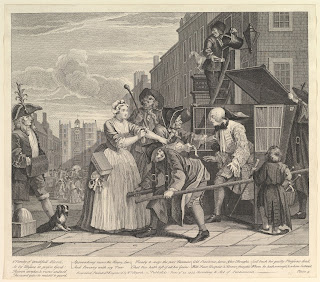 |
| The Madhouse |
In the final scene, Tom Rakewell has apparently suffered some kind of nervous breakdown, and has been committed to a lunatic asylum, as it was probably referred to back then (rather than a psychiatric hospital). It's hard to see, but there's a small sign on the banister on the right which says what looks like "BH". This suggests that the location is Bethlem Hospital, also known as "Bedlam", which had a notorious reputation amongst such institutions.
As Tom is being stripped and shackled by the orderlies, he is being comforted by Sarah Young. She's the only person who seems to showing any pity.
Other inmates seem to include a musician with a violin, a man who believes to be a bishop, and another who seems to be the king.
However, the most notable characters are two woman of distinctly noble bearing, who seem to be visiting the asylum for a day out. I wonder of Hogarth was taken aback by the fact that such a thing was permitted. That maybe so, but their presence does represent a tragic irony for our protagonist; Tom has become little more than an exhibition for the nobility he sought to emulate.
And that pretty much brings it to a close. I'm sure there a plenty of other details that I haven't seen, but I was mainly trying to discern the story from the picture. I hope you've enjoyed this series. I'd best get back to work.










